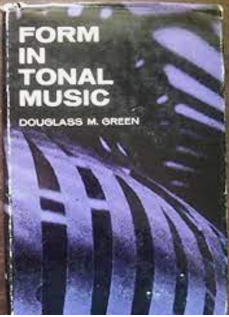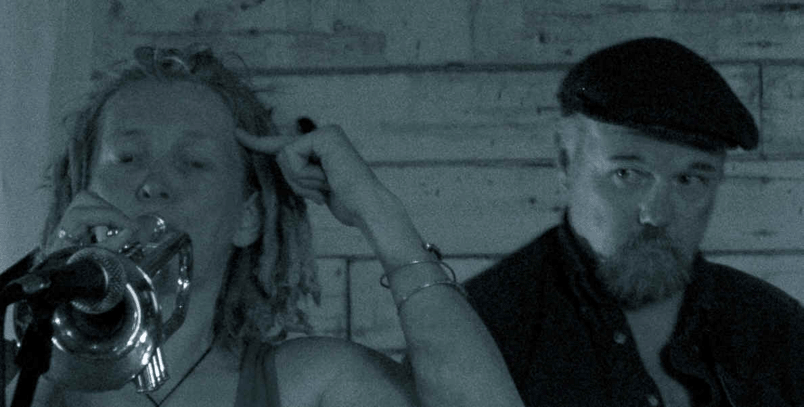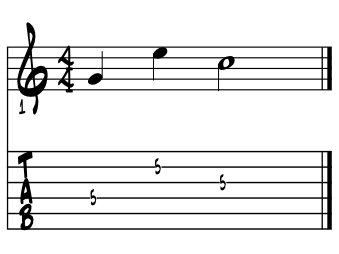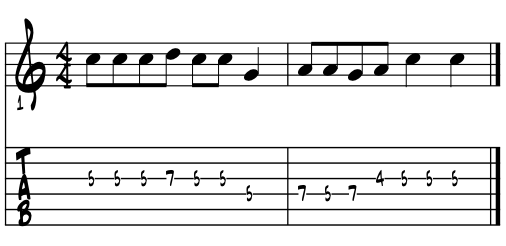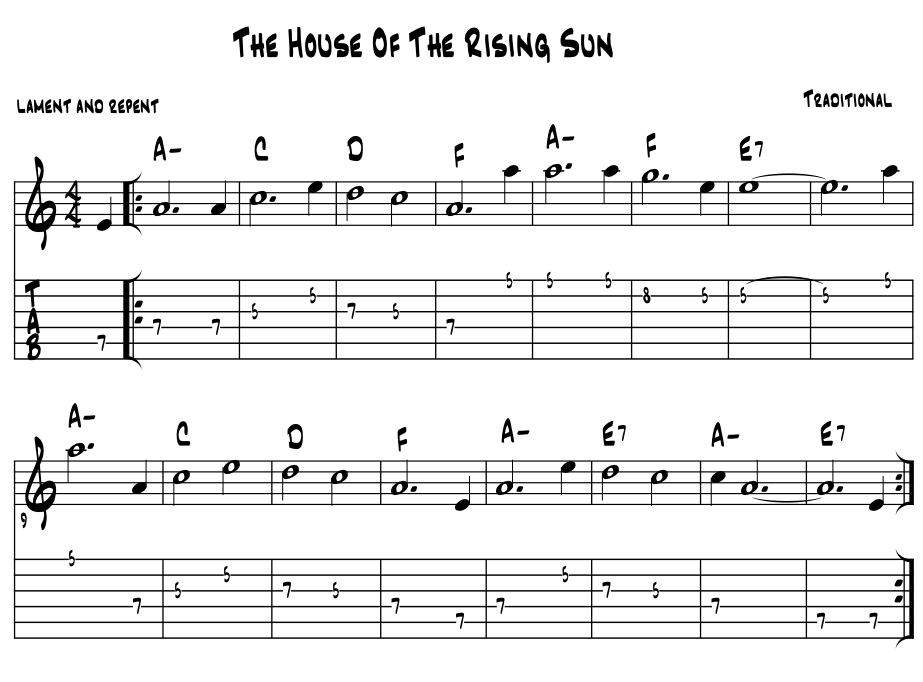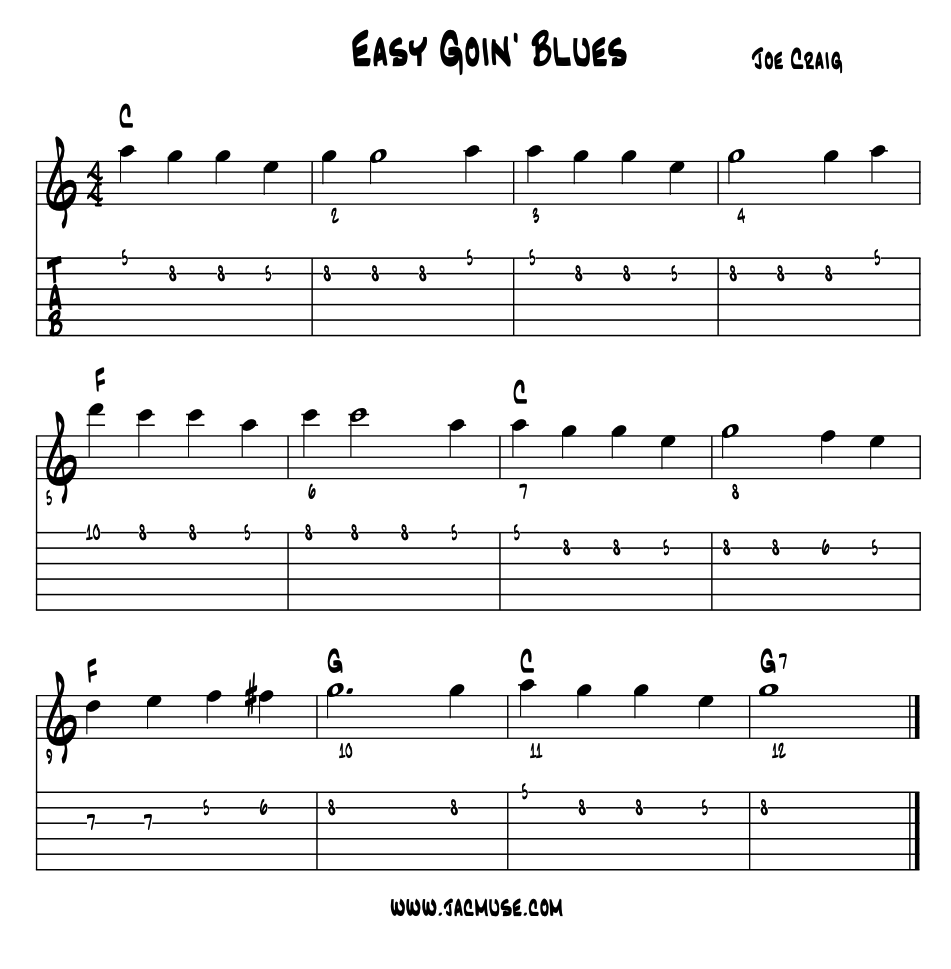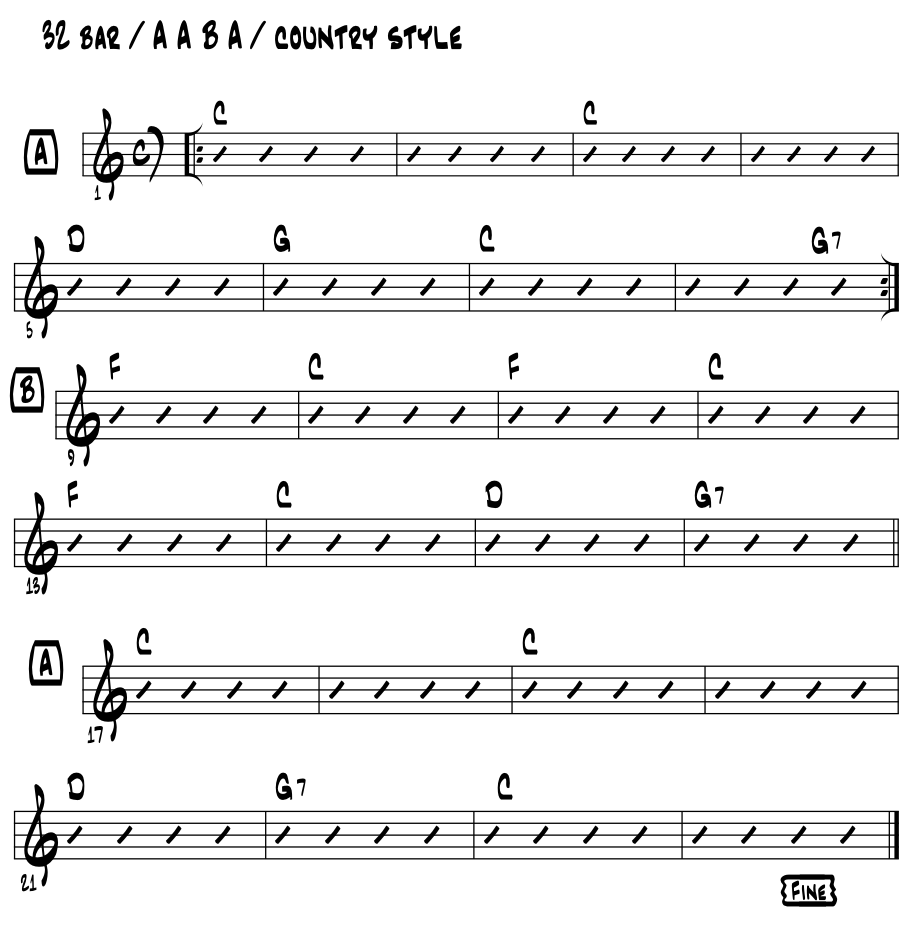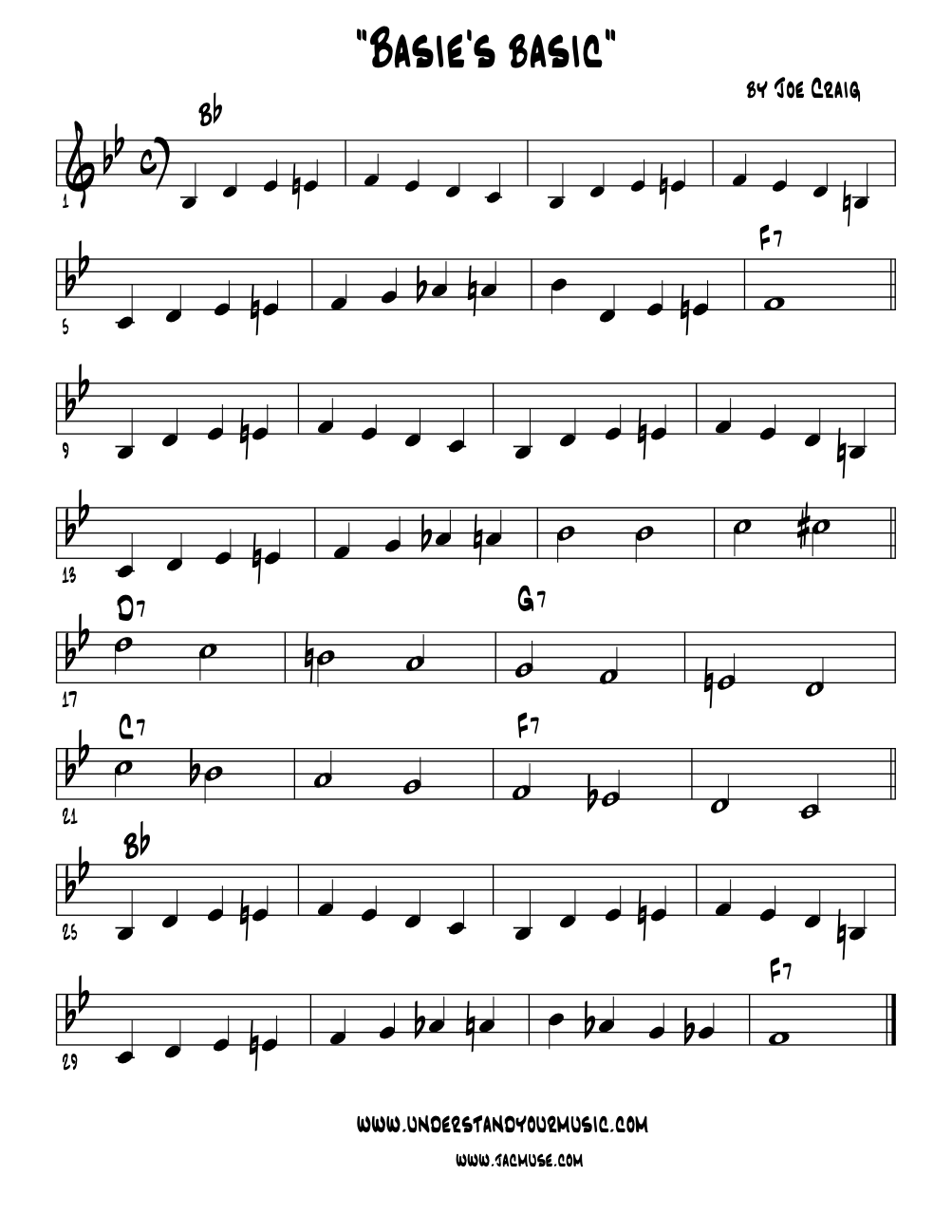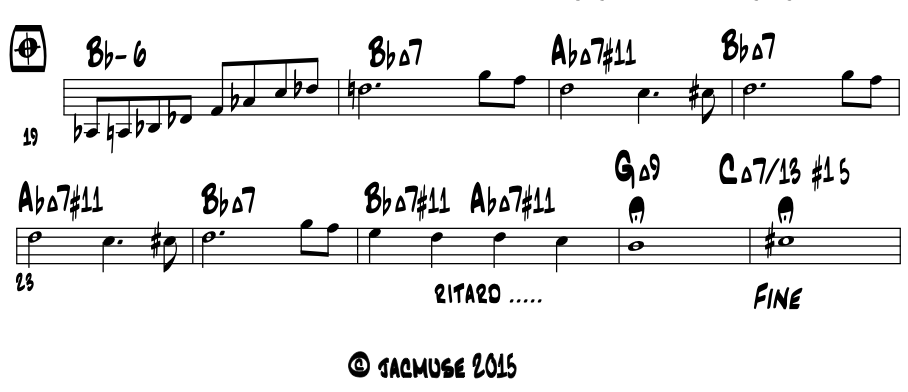Form in Music; two forms. Whether we know of it yet or not, our history can tell us that all the cool arts have structural forms, silent architectures that we build on to shape our ideas into complete works of art. And these 'forms', they evolve over generations. Paintings went from cave walls to frames. Sculptures are 'frozen forms' yet move us through time. Theatre has its stages, acts and scenes. And music has its natural balances that reflect our ways of thinking, creating the rhythm of our day to day lives into patterns, forms and songs. In 'BA' formal academia, the studies to understand form is essential in each of music's main components; in time, in phrasing, in melody, harmony, in rhythms and telling stories.
Two essential forms. Academia loves to parse through 'form in music' as it can help reveal the finest aural brush strokes of a composer. For Americana musics, there's two composition forms that foundation 1000's of songs all through the Americana songbook. We've the pure Americana invention of the 12 bar blues and European 'sonata allegro', the '32 bar song form' extravaganza. |
Find common ground with form. There's so many different levels in sharing our music with others in performance. So it's best for each to define our knowledge needs in regard to form. Knowing that 'form' just might be fastest way to get everyone ( in the band / jamm ) thinking together while moving through musical time, it's good knowledge to have if your looking to gig. For example, you call a 'blues in A.' And in those few words, some good information comes right across to create a road map for the players involved, for now we all can have the same form to lean into together, four or five letter name pitches, a couple of chords and have definite spots in the form; the top, Four, the turnaround, to aim for together, and build up our story as it unfolds. |
If you're just coming to music, knowing that there's just two basic Americana forms simplifies the learning. For most of us Americana folk to jazz players, a song's form is either a 12 bar blues or it is not. And if it's not, we can figure a song's layout by counting measures as the music goes on by. And near every time we'll discover that ...
|
What is a musical form? In my own word filtered through the Harvard Brief Dictionary Of Music; form in music includes all of musical components and their woven together relationships, moving through measurable time, that would distinguish these sounds from any haphazardly arranged sounds, such as the cacophony mashup of urban street noise. |
Tell a story. Form in music is how we as musical artists shape and organize the various parts of our stories; with notes, rhythms and melodies, chords, lyrics et all, our stories fashioned in a structured form are just more presentable and understandable to a wider listening audience. And as we'll see in the following discussions, each 'song' gets to determine how its form 'goes' based on the story it tells; that whatever form it alone needs is fully shapeable with the resources we have. And if not? Well ... we can always invent something new n'est-ce pas ... which we tend to do anyway :) Read on for the basics of building up our most common musical forms. |
Shaping ideas into songs. One of the coolest things about having knowledge with musical form is how quickly composing a 'new' song can come together. For whatever the initial spark for the song's inspiration is, those hip to form will begin to quickly puzzle with what form it'll work in. Blues is probably the easiest and truth be told, any four bar phrase potentially becomes a blues tune if is repeated three times. |
More difficult is when we just get a couple of pitches to spark off a song. This 'lil' bit', if it comes with words, can become the hook. If the hook leans towards a style, and styles have their forms, we're on our way. Author's note. As this talk is starting to drift towards composing, always try to remember the 10 / 90 balance. That often songs start with 10% inspiration followed by the 90% of perspiration in working out its details. How much of a song's form is part of the 90% is hard to say, especially for those who craft the lyrics, which often take their own sweet time to tumble into place. But it's worth believing that having a song 'close up' by its form is just a big help in many ways. |
The balance of form. As we get into this topic we'll quickly see that musical form revolves around combinations of even numbers of measures. Two doubles to four doubles to eight doubles to sixteen doubles to thirty two. At 32 bars, we've reached about 500 years of historical development of musical forms. For instance, an eight bar 'A' melody is repeated, balanced by an eight bar 'B' counter melody, then the 'A' section returns one more time to close the story. So in big section letters, an A A B A / 32 bar form. And that a 12 bar blues, three / four bar phrases. Sort of like 'three's a charm', in that we don't need to hear the line a fourth time :) Often a question is asked. Re-asked to be sure of clarity. Then answered or not, as needed. |
Artistic form is a slippery thing to talk about. Those floating 'mobiles', that hang in the air enabled by gravity to balance all sorts of disparate looking elements of various shapes and sizes, is perhaps a good visualization of a song. For there's probably no pieces that won't somehow fit together. Just that some go together better than others. We as musical artists fit pieces together as they move through time. And just how cool is that? |
Lyrics. In balancing the words of a song, the lyrics of a verse or chorus, we default to a 'king of the verse in the English language', Mr. William Shakespeare (or Billy if you were his mate). Here we delve into the 'iambic pentameter' of verse often found in his writings. An' iamb' or foot, is like our two eighth notes, the second one accented. And 'pentameter' implies something 'five.' Example A. iambic pentameter = five groups of two |
|
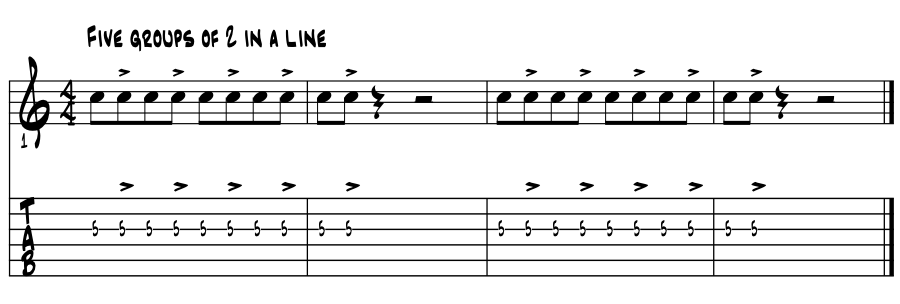 |
Feel the chanting quality of the rhythm? So in balancing the words of a song, the lyrics of a verse or chorus, we might default to this old time way of putting words and rhythms together. |
Form and swing. One of the wonderful things about developing a sense of musical form, getting our wits solidly around any really closed loop, is how quickly that can translate into positive things for our rhythmic phrasing. With a 'beginning and ending' to a phrase, we've a 'complete statement.' Do this organically from our hearts and minds combined, and however short or long the phrase may be, we empower ourselves to fully express our emotional statement in our music, find the best way to express an idea. And if we can do this with just a wee ditty bit of a melody we love, and get this bit to really swing, it'll imprint the heart, mind, hands swing connection on our musical DNA. And gradually through practice, advance and deepen the self expression of our art through all of our musical challenges. |
For the shorter melody lines, the riffs, ditties and hooks, easily become vocalized and create their own mini-forms, thus a good way to get our lines to groove in a vocal like phrasing, yet brought to life by the sound of a musical instrument. For it is in this translation; from our 'vocal' into instrument, that carries the character of our own unique way of phrasing. Let's try one out. So into the waybac machine to find this first lick, which becomes a sort of rhyme or chant of pitches that, once looping around and under our fingers, can quickly strengthen our musicality in many many positive ways. Is this next idea among the first lick we ever learned as kids? Might be pour moi :) Thinking in A minor, example 1a. |
|
 |
Bring a smile ? Cool :) Will this line swing in rhythm ? Surely someway, somehow :) Octaves can help bring the swing too. |
Here's another one of these loops from wayback, a wee bit of a longer phrase. In C major, example 1a. |
 |
Remember this lick from wayback? Sounds like ... 'someone's in the kitchen with Dinah', pretty sure it was also a lick the cheerleaders sang at the ball games. And with the big four beat it'll swing right along :) |
Melody determines the form. If you are now starting out in the study of musical form, it turns out again and again that the melody of a song, and how its phrases are constructed, becomes the determining factor in shaping our various musical forms. We theorists use how a song's melody is phrased, knit together and its measure length to construct a form for the song. Cool ? Once established, when we play the song, we'll simply cycle its form from beginning to end, oftentimes over and over for many cycles, to present the song in performance. This cycling of a song's form from beginning to end we term one 'chorus' of the song. This idea is a key part of the basis of creating and shaping an improvised solo for the song selected to perform. |
A wide variety of terms. As with many of our theory topics, we've a wide variety of vocabulary terms used to describe the various components in the forms of our songs. For each of our styles and the artists that create the magics often have the own ways of describing the ways things go. While the jazz player often has the head, the line, the bridge, the turnaround and the coda, the rocker has the verse and chorus, the blues artist the 12 bar form and three times and out, the pop artist the hook, the bluegrass artists the breakdown. Curiosity wins the day in all of this as those who are 'never to old to learn' will continue to learn new things and evolve, thus never really grow old :) Telling our stories in song is the goal, using whatever works best, the terms that describe the component parts best to the players at hand. |
A second 'silent architecture.' Somewhat similar to our silent architecture of our pitches, musical form is a similarly silent component in our aural musics. While we often can feel the form through various musical devices, in some music the form is purposefully hidden so as to create a seamless flow of the music. In some advanced styles of jazz, to 'make the bar lines go away' is the goal, which can also further 'silence' the form of a song. That said, our first task here is to ... |
Where a melody begin at the 'top' of the form. As in any closed cycle of events, finding the beginning of the loop is often key to understanding the form. In music we call this the top of the form; the downbeat of the first measure at the beginning of the song, melody, words etc. Hear the top, the pitch 'G', the downbeat on beat one after the pickup notes of an Americana classic. If we we're counting measures this is our starting point. Example 1. |
 |
Cool? Know the rest of the melody line from just hearing its top? The pick up notes create the anticipation to the top of the melody line, thus the top of the form. The 'G' note is the downbeat on beat one, designating it as the 'top' of this song's musical form. This is the spot we need to be able to identify in our musical forms. Every tune has this spot we call the top. Once we recognize it, can feel and hear it, we're golden for an awful lot of Americana musics, knowing our place in the music when performing and begin to have our 'arms around it' for creating our various forms of improvisations. |
So, have this line under your fingers yet? Do learn it here if need be for the swing is built right in :) Notice the double bar lines before the 'G' note? That designates the beginning of a section within a musical form. |
Easy to distinguish when the written melody of a song is being sounded, the tricky part often occurs when we get to the improv sections, so common throughout all styles of our Americana musics. And our challenge ramps up as the form of the songs and our solos get longer. For as we delve deeper into what the written harmony of the song provides for soloing ideas and move further away from the melody, keeping everyone involved on the same page and together often falls to the form of the song. |
And while there are other 'mileposts' to mark the form along the way in any song really, sensing and hearing the downbeat is the way many of us keep track of the form. This is part of the reason and method that many evolving jazz cats play 12 bar blues; to strengthen their sense of form and their ability to create cogent phrasing that is molded to this form created by three, four bar phrases. So can you hear the top of our 12 bar blues form? |
Twelve bar blues. Just about every song we dig, in any style really, will have its measurable form. Further into this discussion we'll take these measurements apart bar by bar, gradually adding to create the larger forms that shape our song. Right now we want to simply establish what the 'top' of any musical form is. The 'top' is simply the beginning of the song where the melody starts. Click the music and find the top in the audio, simply where the melody starts again. Try to count the number of times you here the top, and thus the number of full choruses in the example. Example to 'hear the top of 12 bar blues for, in the key of 'Bb.' |
Here the form / improvised melody start over each 12 bars ? Cool. How many times ? Each time through the melody we call one 'chorus.' |
Da capo. Literally 'the head', very common in complex improvisational formulas to signal that the 'top' of the form or song or jamm or whatever is coming up soon. Leaders will often signal with a gesture, like this :) |
|
And at the bottom ... the turnaround. Once a song is in motion, hearing the downbeat at the top of a song's form is helped by creating a sense of its impending arrival. We do this in what is commonly termed the 'turnaround', which lives at the bottom or end of the form of a song being performed. As its name implies, the turnaround turns us around and back up to the top of the form. In the following written music we also get the repeat sign at the end reminding us to go back to the top, signified by the other half of the repeat bracket. Ex. 2. |
 |
For improvising musicians, this 'solo break' is the portal or gateway to the next chorus. In this usage, the word 'chorus' implies playing one time through the complete form of the song. We'll soon see this term again meaning something different. Verse / chorus? As in two different parts or sections of a song? Yep. |
As players strengthen this turnaround part of the form, their solos can get longer. For they can string more choruses together by boldly stating their intentions to continue. Often slang termed 'ride time', the ability to link choruses together creates a format for longer, more involved stories to be told. Solos can either be improvised or worked out, or any a combination of both. Most of us create from our existing ideas. Drawing on these memories to tell our stories and create our solos. |
Quick review. All of our musical forms have a start and an end point. The 'top' and the 'turnaround' are the two bookends we commonly find in all of our musical styles. For just like in telling any story, we enjoy a beginning and an end, a hopefully a surprise or two along the way. Once we understand the sense of closure to any length of musical phrase, and its oft repeated cycling to create musical form, there's really no limit to the ways we can artistically shape a form to hold our ideas. That some storytelling or musical forms are historically more common than others is the topic of our discussions here. So we've a beginning and an end. Now for the middle. |
In the middle / verse ~ chorus ~ bridge ~ hook. Well now that we've examined the common beginning and end points of musical form; the downbeat at the top of the form and the turnaround at the bottom, which gets us back to the top, deciding what's in the middle and how it is commonly labeled becomes the next task at hand. Lots of variability here for this labeling of the parts of musical form. Be flexible and find which terms work best for you and the players you're working with. |
The verse. The verse of a song is usually composed of words with a melody that tell the story. Often told by one voice; the 'storyteller.' An oldtime Americana verse; "I come from Alabama with a banjo on my knee ..." sets the story in motion while we often learn of its characters and their doings in the verses of a song. |
|
The chorus. "Oh Susanna ... oh don't you cry for me ..." The chorus of the song is the part that often sums up the tale, and gives us the 'moral' of the story being told. It oftentimes has a different melody than the verse. Thus providing a further contrast between the two parts. And in a more traditional definition of the 'chorus'; a group of voices that sing together, we find a similar use here; that everyone involved has the opportunity to join in and sing along with the words and melody of the chorus. |
|
The bridge. As its name implies, the 'bridge' in the form of a song connects various parts together. Also known as the 'middle eight', most often there's a different melody and words in the bridge than the verse. While the bridge and chorus are often used the same way in conversation about form, the bridge is usually the term for larger or longer songs; songs with more measures and definite sections. As we'll see further into this discussion, we usually associate the bridge in 32 bar song form. |
|
The hook. As its name implies, the hook of a song is a catchy phrase of words, or a melody line that get 'stuck' in our heads upon repeated hearings of it. Oftentimes associated with pop music and a big part of 'top 10' hits, the hook is most often a 'turn of words' that a song is built around. Often coming right out of the blue, or from an experience we're having or a turn of phrase we hear from whatever source, many composers will first come up with a 'hook', then build the tune around it. |
Ever hear the phrase ... 'oh, that would be a great hook?' Well, you have now :) Each of our Americana musical styles have their classic songs with their hooks, which is very often the title of the song too. "Oh Susanna" surely qualifies as the 'hook' on many many compositional and marketing levels. In instrumental music, the idea of a hook usually translates vocabulary wise into the main theme or melody of a song. |
Sections / section letters. As we advance in our studies of musical form, and this is especially true in larger compositional forms, we think in terms of sections that we glue together to make the whole piece of music or song. While we discussed various parts of a song just above, we can also use letter such as 'A', 'B' and 'C' to designate sections in our compositions. |
Reading musicians will follow the chart, a road map of a song, often using these letter named sections to navigate around. Most often the different lettered sections in a work contain different melodies, chords tempos etc. Placed at the beginning of a phrase, these section letters in a score often will look like these two; the 'A' and 'B' placed into the square shape. Example 3. |
|
Letter 'A' or letter 'B' become designated spots in the music that give players reference points to help get and keep everyone together as the music moves along. In an instrumental song, the 'A' section is also the main melody or hook of the tune. Usually an eight bar phrase which is repeated, so 16 bars total. The 'B' section is the bridge which is the counter melody to the melody of the 'A' section. Yin / Yang balance? Yep. There's also a section 'C' later on in this song that takes the mood to a different vibe for the initial soloing and improvisation. |
Melodic phrasing shapes the forms. By realizing that many of our most common musical forms are structured by the looping of a song's core idea or motif; the central phrase within a song's melody line, we can gain a way into understanding how the various forms that shape our music are built up by composers. In what now follows, we numerically 'build up' progressively longer musical phrases bar by bar and watch how our musical ideas can loop and organically grow into the musical forms of songs most commonly found within our Americana styles. In Americana musics and really all musics globally, this 'motif' can and often is a rhythm idea. |
A one bar form / phrase. This first entry is surely more of a rhythm than a melody phrase. Regardless, we've got to start somewhere. We can lift this one measure idea from our Native American brethren, find the four beats to the bar that cores so much globally let alone our own Americana. That this one measure repeats and loops on forever is the heartbeat of drum circles and the pulse of life. So while not a recognized 'form', this one bar repeated is a source for all. Example 4. |
|
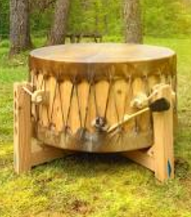 |
Hear any pitches or melodies as the drum sounds? The ancient melodies, and modern ones too, are all within our memories. That a boom boom boom boom can conjure them forth is magic we never want to lose. |
Three pitch melody. This next idea is a three pitch melody that I've heard from bell towers to 'announce' the hour of the day. These three pitches are sounded first, followed by a number of chimes depending on the hour of the day. Example 4a. |
Into the wayback. This idea goes back to when we were kids and is probably part of a longer melody that I do not really remember. So maybe a 'first hook?' Example 4b. |
A two bar form / phrase. Doubling up the length of our phrase to two bars opens up our creative into a rather vast universe of artistic potential. Why? Well, now that we have two possible parts we have; various ways to balance, color and contrast one part to the other. We can create the age old two part 'call and response' dynamic, and we have the back and forth 'perpetual motion' of the dance vamp for starters. That these sorts of artistic filters also create melodic motifs or hooks for further development and looping should remind us of their importance to explore their possibilities. Here's a common enough 'two chorder' vamp with a downbeat on 1, giving it a solid rock bottom feel. Example 4bb. |
|
Some would consider the two bar vamp as a musical form, especially when there's chords involved as in the last idea. For it has been used extensively throughout the decades for some very big hits. Into the wayback machine to find this melody. Example 4c. |
As a vamp. Not sure where this last idea comes from, way back for sure. I think as kids we sang it when one of us was in a bit of trouble to sound out the impending parental doom, thus the tritone in the lick :) This next two bar idea, which also goes way back, is a blues staple. Example 4d. |
Surely a lick many a bluesman and rocker would know. Very 'Doors' like yes? |
|
On the brighter side of things, here's a little two bar pentatonic ditty from the schoolyard. Example 4e. |
Nice melodic closure with just two bars. Easy lick to expand through sequence or permutation |
Iambic pentameter. These two bars of rhythm go wayback in our English language and literature. 'Iamb' meaning two paired syllables, one 'unstressed' followed by one 'stressed.' So, in music, unaccented followed by accented. Eighth notes? Sure. 'Penta' means we've five of these iamb's. So, dig how nicely they slip into a two bar phrase. Example 4f. |
|
Surely Shakespeare was a fan of this rhythm and all sorts of variations in rhythm and time. Accenting the off beats and thinking 'even' 1/8's, we build the our own ultra modern modern swing rhythm right onto 400 plus years of English literature. Imagine that ... :) Lyricists take note of this, not really sure why, but if it rhymes, it rhymes :) Do learn about and master this iambic pentameter phrasing. Perhaps start by finding different ways to fit it into measures by using different start points of the phrase. One, and of one, on two, and of two etc. |
"The more upbeats you have in the music, the more it swings." |
wiki ~ Dizzy Gillespie |
A three bar phrase. As we doubled from one to two measures, just can't go half to find three. And truth be told, not a thing comes up that is a true three bar melody. Nada. Suggestions ... ? We'll keep thinking ... :) So then off to the land of plenty ... four bars ! |
Children's song form / a four bar phrase. The four bar phrase is probably the basis of it all. While we get tons from two bars, a lot from one and a bit from three, the four bar phrase rules the day in our Americana musics in all the styles. As the building block in the larger forms, we'll knit four bars phrases together in various configurations to create the various song forms of our modern musical world. Curiously, most of what we hear on the radio, on any station that plays any style of Americana, breaks right down into a four measure phrases. Often linked together to one another, four gets doubled into eight and eight is the length of phrase that creates the standard song forms, which we'll get to shortly. In the meantime, once a song's phrase is balanced to satisfaction, arrangers can take over and reshape and place this line into non- four bar phrases, putting a twist on things. And when a six or seven bar gem comes along, we shrug, say 'hallelujah' ! |
|
So, four bar songs for kids are often just mini versions of larger, more complex forms for longer and more involved stories. So just keeping it simple for stories and songs for the wee ones? Yep, often just a couple of pitches in a couple of measures to ease on into our rote learning process with more fun for all. Remember this four bar ditty? That this next idea might be more of a nursery rhyme that a song is noted. Example 5. |
 |
I think I've heard this "Hot Cross Buns" quoted by some geezers over the decades, which usually brings some smiles to the whole process. |
|
A four bar modal blues form. This is a rare bird indeed. I've only heard one recorded example of it, now over four decades of active theory listening and even with today's search engines, cannot locate the track as I heard it created by pianist Marcus Roberts. Essentially the form is simply a four bar phrase repeated, harmonically based on a blues' V7 chord, repeated until the idea is finished. A four bar modal blues in 'C.' Example 5a. |
|
Hear this wanting to go somewhere? Maybe to the Four chord at some point? That 'wanting' just might be the built in energy that propels this form. Again, this modal blues is rare. Although as I write this, the musical art of Sun House comes to mind. |
|
Four, four bar phrases. Not to get too far ahead to quick, but in a rather timeless melody today we can find a 16 bar measure song that glues together four rather distinct four bar phrases. Probably around for the last four hundred years give or take, just a perfect balance of four unique, four measure phrases to form a timeless melody for us to enjoy today. For those readers here who gig, while tricky for sure, this is a great tune to perform as probably everyone in the room will know it :) |
In a flash, four bars can become eight. A very common feature of a four bar melodic phrase is to create what we call a second ending. In this format, we're basically using the same four bar melodic idea but shaping the end of the line so that it feels as if it wants to continue on, not quite complete just yet. By the end of the second statement of the phrase, we get the sense of the melody coming to rest and closure. |
An idea for drummers. As the drummer in a group is generally the motor that 'marks' the time and tempo chosen by the group for the performance of a song, I've heard advanced players consistently signal the beginning of each new four bar phrase as it comes along. Kind of like mileposts along the road, it reminds us of where we are in the form of the song. In listening to the radio we can hear this also. It might not always be in the drummers part, but something usually happens at the close of or the beginning of each four bar phrase as they come along in the arrangement. This happens over a wide spectrum of musical styles. |
Five bar form / phrase. The country classics "Jolene" penned by Dolly Parton and "Blue Sky" Dickey Betts with the Allman Brothers both have solid five bar phrases for the statement of the lyrics. In both cases, the phrasing of the words end at the close of bar four, then there's four more beats for natural balance. |
|
Six bar form / phrase. While nada again applies to our form and phrasings, there's some rather famous six measure sections in our literature. The song "My Country, Tis Of Thee ~ America" opens with a six bar phrase, followed by an eight measure section. Also we'd be remiss if we did not point out a song that won the Grammy Award for song of the year in 1967 that features the rare as hen's teeth six bar A section. And while the bridge or B section is eight bars, perfect artistic balance is magically achieved in an epic song of true love. The song? Why, Paul McCartney's "Michelle." |
|
Seven bar form. While nada still applies in there being no honest to goodness historical long established seven bar form, we'd again be remiss in not pointing out that in the top 10 songbook, a place where any Americana songwriter would dig to hang, there's seven bar phrased songs gems a plenty. And like all gems, we just got to go find them. A seven bar A section as a seven bar phrase, hmmm ... Yet the power of the story of the words over the structural form of the music? Let no form impede the story to be told and the crafting of the magical words in its telling. |
|
Composers. Use these song to write a few of your own. Use the hook and parody, use the hook with new verses, use the form and chord changes as an' architecture', and rebuild a new song of yours. No one owns the form or changes of the chord progression, so what ya make new is yours. It is the melody and words we can copyright. Great art inspires great art, and we all share the pitches. |
Eight bar form / phrase / compose. Adding in just one more measure makes all the difference in our local universe of musical form. For at eight measures of phrase length, our form really comes together. For as we'll soon see, we not only have a workable length for a complete song form, we'll also use eight bars as a set in stone building block for larger forms, creating the structures that have shaped our melodies for at least a couple of centuries now. This first eight measure song is pure Americana. Example 6. |
|
This song has been played or recorded by just about every blues artist in the biz. It's all over the web if you be so inclined. Lots and lots of web based instructional / video material based on this eight bar gem. |
Master this chord progression and its 8 bar form. Learning the basics of "Key To The Highway"; its pitches, bass line story, chords and combined rhythm create a 'master key' to help unlock other songs in Americana musics. Combine knowledge of this eight bar song / form with the 12 bar blues song / form, and a lot should fall into place for making your own music too. |
Composers. Use this song to write a few of your own. Use the hook and parody, use the hook with new verses, use the form and chord changes as an' architecture', and rebuild a new song of yours. No one owns the form or changes, so what ya make new is yours. It is the melody and words we can copyright. |
Eight bars of jolly. Well was hoping bigtime to include the perfectly balanced eight bar melody that everyone probably knows titled "The Hokey Pokey" / USA. Unfortunately, while free of copyright restrictions in Great Britain and other points beyond, not so here in the United States. Oh well, you'll have to take me word for it and find a chart yourself. Just a solid eight bar tune that filled the dance floor. So here's another jolly sort of eight bar melody, not intended to fill a dance floor except maybe a school gym, yet one with the 'big quarter note swing' built right in. And while mostly for the kids, if we can get this line to swing, chances are we'll find the magic in the pitches and rhythms of other melodies too. Example 6a. |
|
Just a super solid eight bar gem. Need this for a kid's show and want to jazz up the arrangement? Try modulating the tune up in half steps. Maybe a couple of times depending on how much time you have. Combine a rhythmic feel of the swing thing with a couple of modulations, should get the youngsters going :) |
With a second ending we double 8 to 16. So just as with the four bar phrase discussed above, with a bit of a melody twist at the end of the phrase, easy to repeat our melody a second time and in the process enlarge our musical form. Most times this 'twist' is simply ending the line with a diatonic V7 chord instead of a tonic One chord. This encourages the continuation of the line, again enlarging our form and extending the story we are telling. This next song is in A minor, so we see the close of the first line on its altered Five chord, 'E7.' Ex. 6a. |
Know this melody yet? From way back across the pond, this song was a big big radio hit back in the 60's. Learn it here if need be if you like the line etc. |
|
Eight measure sections. At eight bars we probably reach the most common balance point in our musical forms. We have complete eight bar songs. We have eight bar songs with a first and second ending and we have eight bar sections that we build into bigger forms. Often using section letters in written songs, there are two basic forms; 'A / A / B / A', where each section is eight bars. And the form 'A / B', where each section is 16 bars, so two eight bar phrases. |
Song form / sonata allegro / ballad form. Here we delve towards the Euro classical music theory and history for our background. For this sonata allegro was the main form for writing the opening section to all sorts of works; symphonies, concertos, string quartets etc., over a couple of centuries; like from 1500 to 1899 or so. "Hey Good Lookin'." Our own Americana 'A / A / B / A 'song form' is mostly just an abbreviated form of classical sonata allegro, it is like exactly 32 bars ... and songs written in this 'exacting' of forms are thus easy jamm on, once we've got a sense of it, hip to the changes. For folk, country and bluegrass leaning cats of all stripes and spots, Hank Williams' essential song "Hey Good Lookin' is the one to master. For it's a perfect 32 bar form gem of a song, two themes ... three chords and the truth harmony ... plus a Five of Five in the bridge, which is the chord motion that opens up a clear pathway for all jazz leaning country and bluegrass cats of all stripes and spots. We get to hear a superclear mini 'cycle of dominants' in a super clear setting, fun story and lyrics that bring smiles. For like the twelve bar blues, once in the know, it is 'easy' to hear the changes and form. Thus empowered with the 12 bar form deep, chances are you'll never get lost again, at least in most Americana musics, till we start to really 'jazz it up. 'Listeners of all stripes will easily follow along, easy to keep the feet under the body when on the dancefloor; as we can intuitively 'hear and feel' where the song is a going :) |
|
Traditionally, sonata allegro is usually in three sections, there is the exposition, development and recapitulation. These correspond to our section letter 'A / A / B / A.' So our first 'A' is the exposition, our main melodic idea is most always eight bars in length. We repeat that. We use the same theme but usually twist the end of it to set up the new bit of melody in the bridge, the B section. Our bridge is the development section of sonata allegro. More of a counter melody than the classical development, although often in a different key as with sonata allegro, the close of the eight bar 'B' section sets us the return to the last 'A' section. The last A section is the recapitulation. Here we restate the original melody and bring the song to its close in its original key. A A B A |
|
So in this 'A / A / B / A' form each section is eight bars, making a total of 32. The other main 32 bar form we use, 'A / B', so two main sections, works better when the first theme idea runs longer. Most often there's a sequence or modulation to Four in the line, so it runs to 16 bars in length. In these songs the second part or 'B' section is mostly a repeat of the first idea but with a noticeable difference in the close of the melody, thus the 'A' and 'B' designations. Melody shapes and decides the form generally. No tail wagging the dog here please, leaving the finer points of the analysis for a rainy day. |
Nine bar phrase. Crazy but true yet again, we go back to the Beatles for a uniquely shaped phrase. This one nine bars George Harrison's "Something." Find the original and count out the A section phrase aytp. |
|
Ten bar form / phrase. Super rare is the 10 bar phrase. So rare that if there is a song written with a 10 bar phrase, that also is an Americana standard that went top 10 multiple times, it must be a gem. We've two gems right out of the gate. The story line and supporting music of "Shenadoah" quickly takes us all the way back, to a simpler time in our histories, to help us renew each day today. And then there's the song that tells us a timeless truth about the natural way of super sentient everyday living, for the main melody of "God Bless The Child" is a 10 bar phrase that Billie Holiday imagined and brought to us in song :) |
|
11 bar form / phrase. Nada really, these odd numbers tend to be tricky to balance up I guess. Suggestions? |
Twelve bar blues or three, 4 bar phrases :) At the 12 bars mark we get the essential '12 bar blues.' Imagine that :) Not that blues songs were always 12 measures, or that there's not variations, but there's too much in today's music, written in this form not to be acquainted. Hearing this form through all the styles is a great accelerator in learning new songs. |
Using the 12 bar form to quickly create 'head' arrangements to capture the new ideas as they come along is quite handy. For once a melody is in a song, we really got it forever, less chance of getting lost. And surely no reason why such a newly captured idea won't be developed in another form; again the idea that 3 / 4 bar phrases is often one phrase repeated three times to make the form of a 12 bar blues, with the last bars of the last phrase shaped a bit different or not, to include the turnaround getting us back to the top of the form. |
Everything from the blues through to rhythm and blues and on into the early rock and roll and points beyond is has essential songs in this 12 bar form. If you work to get this form rock solid, can always hear the top of the form while listing to real music as it is performed and know the essential 'Muddy' turnaround, safe to say you're well on your way to makin' some Americana magic and the get the dancers up to sway ole ! Looks like this. Ex. 6b. |
Thirteen through 15 bar form / phrase. Nada really, these odd numbers tend to be tricky to balance up I guess. Suggestions? |
Sixteen bars / form. If you've read from the top of this discussion, surely by this point you know the math so to speak and can understand what 16 measures can bring us. Four four's. A couple of eights. Two eights with a tag. A 12 bar blues with an extra four bar tag. Half of a 32 bar form. Regardless of how we get here, 16 bars is a key juncture in our study of musical form. Also consider getting "Going Down The Road Feeling Bad" under your fingers. Three chords and the truth, 16 bar form and the Americana real deal, what's not to love ? |
|
Seventeen through 23 bar form / phrase. Nada really, these odd numbers tend to be tricky to balance up I guess. There is the folk, country, bluegrass classic "Friend Of The Devil", with a 20 bar 'A' section and 18 bar bridge, or 'B' section. Other suggestions? |
|
Twenty four measures / form. The only thing that comes to mind is a sort of 'double' 12 bar blues. So a 12 bar blues with a first and second ending. One composition that fits this bill is "Sugar" by jazz and blues tenor saxophonist Stanley Turrentine. |
|
Twenty five through 31 measures / form. Nada really, these odd numbers tend to be tricky to balance up I'd imagine. Suggestions? |
Thirty two measures / form. Thirty two bars is sort of the end of the road here in regards to Americana musical form. Mostly a form for what we call standards, the list of songs in this form is probably endless. For the music here spans now about 100 years, from NYC's Tin Pan Alley to today via Nashville, Motown and LA, global too, so London of course and beyond. There's two common ways we get to a 32 bar total. Four groups of eight bars and two groups of sixteen. In section letters these commonly become A / A / B / A for the four, eight bar phrases. A / B for the two sixteen bar phrases. While they both add up to the same 32 bars, the distinction between the two is determined by the phrasing of the written melody. Turns out that not everything is a four bar phrase. Imagine that :) |
|
Rhythm changes ~ A A B A. What jazz players know as 'rhythm changes' is the 32 bar A A B A form. This song form is based on the Gershwin Brothers composition titled "I Got Rhythm." There's a ton of variations on these basic chords and all sorts of melodies. The B section harmony is a sort of 'catalogue bridge.' Just a standard and mostly generic progression, from the old days of when the 'Sears Roebuck" catalogue was the go to for everything needed. What is not all that negotiable is the 32 bar form. And jazz artists globally will probably know what to do if you call on the bandstand ... 'hey let's play some rhythm changes in Bb.' Here's a chord chart for the generic chords which without a melody, are not copyrighted so can be included here. For our melodies / lyrics is what we copyright. Example 7. |
|
A rather perfect 32 bars yes? As this is a jazz form so kind of rare through the other styles of Americana. Experienced players often want to count this off at 200 or so and beyond. For like the 12 bar blues, the strength of the form is fairly unbreakable, even under the craziest conditions. There's a few 'jump' or 'head' tunes associated with this form, perhaps most notably is "Jumping At The Woodside", a famous song for the Count Basie Orchestra, from 1938. |
|
"Hey Good Looking" changes. From the 1950's the country classic "Hey Good Lookin" by Hank Williams, is just a perfect song to master and 'theory know' inside and out. Easy and joyous pentatonic melody. Basic basic all major chords. Like "Dock Of The Bay?" Yep. |
|
In "Hey Good Lookin", most of the chord cycle of the A section are eliminated as we 'un jazz up' the changes, we simplify things so the words of the story tell the tale. So, less is more here, and as we reduce the number of elements, we hear a style shifting. Back towards 'three chords and the truth?' Pretty much yes. |
In the B section, our harmony goes to Four, then Five of Five, then Five, then back to tonic One in the last A section, to close this 32 bar form. So a bit different from 'rhythm changes', yet still a 'Sears" bridge. While as 'Americana vanilla' as it might in theory ever get, total hit cover song for lots of big stars and just a total hoot to play depending on the gig / room etc. Thinking in 'C' major, which is the key on William's T.V. recording, here are the basic changes and 32 bar form. Example 7a. |
Cool? Learn this form here if needed. It'll come in handy at some point. And do search around and find a recording, fun song with lots of the 'silent architecture' we theorists are curious about. And ... look what happens when we use these basics and jazz 'em up :) |
Basie's Basic. All about 'Bb' rhythm changes bass line story into rockabilly with a Sears 'guide tone bridge' cycling on back by 4th's to One, from a maj. 3rd above. Classic all the way in the Basie "Jumpin" way. Ex. 7b. |
Cool ? And hearing hints of additional chords suggested by the melody line ? Cool, write yours in, and improvise lines through the changes. College level study of jazz improvisation includes 'hearing the changes in the line.' And know that in traditional improvisation, it's a measure of how well we know our craft. And as there's probably no end to chord substitution, they'll be no end to the lines that run on through :) Worth the time to rote. Getting this last song solid with clicks will open a big door into Americana musics through our spectrum of styles. For like rote learning the the stand alone forms of '8 bars' and '12 bar blues', most of the songs we play are in one of these three loops, or will combine parts included in these forms. Advancing players should strive to get through these forms with a metronome. For when shedding 'in time' or with the time of the clicks, all of our necessary musical faculties and skills come together and strengthen a bit more, with every chorus we take. |
Strophic form / through composed. We place these two forms together as they are for the most part 'polar' opposites to one another. The now age old strophic form uses the same music for multiple stanzas, of different lyrics. Each repetition a 'stroph' telling a part of the story. Early heavy rockers Led Zepplin's "Stairway To Heaven" is written in strophic form. "In The Year 2525", "Blue Suede Shoes" other top 10 hits are strophic form. Twelve bar blues songs are usually strophic formed. |
|
Through Composed. On an opposing side of 'strophs' is through composed. Here the music is oftentimes an ever evolving aural background for the lyrics as its story unfolds. The music is composed 'throughout' the song. In 32 bar A A B A form song, oftentimes there's two unique musical parts, often in different keys too. Movie scores are often through composed, with motifs and riffs assigned to certain characters or themes of the plot that reoccur throughout the piece. There's 'art songs' that are through composed, a worked out arrangement to fix exactly with the poetry. There's also poetry set to improvised music, a throwback to the old days when piano players played along with silent films. |
|
Coda. Well, as we get to the close of this discussion of musical forms, we find the coda. An Italian word for 'tail' the coda is the last couple of bars of an arrangement. Most often in addition to our standard forms, in written music we look for the coda sign, or as Doc Miller often called it ... 'the bug :)' The coda symbol looks like this;
Most times the 'bug' symbol is somewhere in the music, usually at the end of a section, with its measures written at the bottom of the score. On the last pass through the performance of the song, we 'take the bug', which gets us to the end of the arrangement. Codas often have a something special in them, leaving the listeners with a bit of a surprise and smile at the close of a song. It generally looks like this in the music. Example 9. |
|
This last tune is one of mine, not sure if there's a famous coda out there worth noting, there must be though, stay tuned :) Oh, the coda in should 'Hey Jude" will qualify :) |
|
Exceptions to the rules. So, had enough of being boxed into this or that number of measures, and that many sections, plus a coda, and all even numbers of measures? Well, now that you know these basics, don't let the rules get in the way of creating your art. For there's no right or wrong here, just what works and what might not work as well in shaping our ideas. Things we write early on in our careers might later seem juvenile. Who cares. Just write, play, have fun and share your music. If you make music to get folks up dancing and they do dance to your grooves, you won the gig. For knowledge of form and the 'rules' helps you to hang with other players, quickly get on their page and stay there. Form in music keeps the band together when nothing else will. Form will find common ground instantaneously if you're on the bandstand and need something sooner than 'right now.' That there's just a few forms really, and all based on the four bar phrase. Just master this phrase, count it aloud a couple of times, listen to its beginning and end points in the music you dig, and focus on beginning to hear the beginning of a new phrase. Hip your bandmates to these ideas and marvel at the results in the music. Here's the basics of the rules; |
1) Learn the rules first and emulate them in your work to solidify your understanding, then we break them if our phrases necessitate such actions. 2) Historical tradition creates the rules, new creatives in succeeding generations evolve them as needed. 3) Evolution is based on an artistic need to express. |
Review. Our musical forms are based on the balance we create with words, expressions and motions we find in our everyday lives. Extracting a piece of any of these, we can build up a work that is shaped by common forms that we've had through the many many generations of musicians that have come before us. Working both ways; shaping an idea into an existing form as well as well as shaping a form to fit our idea, gradually these meld and we have the best of both; to create the balance of content and expression in our creative works. In finding this balance we can have a greater 'universality' of delivery that can be intuitively perceived and shared by all, regardless of their own personal interests in art, music and beyond. |
"What is remarkable about Western music is that by its chosen scales, modified through equal temperament, and by developing complex forms and complex instruments, it has raised the expressive power of music to heights and depths unattained in other cultures." |
|
References. References for this page come from the included bibliography from formal music schools and the bandstand, made way easier by the folks along the way. In addition, books of classical literature; from Homer, Stendahl and Laudurie to Rand, Walker and Morrison and of today, provided additional life puzzle pieces to the musical ones, to shape the 'art' page and discussions of this book. Special thanks to PSUC musicology professor Dr. Y. Guibbory, who 40 years ago provided the initial insights of weaving the history of all the fine arts into one colossal story telling of the evolution of AmerAftroEurolatin musical arts. And to teacher-ed training master, Dr. Joyce Honeychurch of UAA, whose new ideas of education come to fruition in an e-book. |
"Life is about creating yourself." |
wiki ~ Bob Dylan |
Find an e-book mentor. Always good to have a mentor when learning about things new to us. And with music and its magics, nice to have a friend or two ask questions and collaborate with. Seek and ye shall find. Local high schools, libraries, friends and family, musicians in your home town ... just ask around, someone will know someone who knows someone about music who can help you with your studies of the musical arts with this e-book. |
Intensive tutoring. Luckily for musical artists like us, the learning dip of the 'covid years' can vanish quickly with intensive tutoring. For all disciplines; including all the sciences and the 'hands on' trade schools, that with tutoring, learning blossoms to 'catch us up.' In music ? The 'theory' of making musical art is built with just the 12 unique pitches, so easy to master with mentorship. And in 'practice ?' Luckily old school, the foundation that 'all responsibility for self betterment is ours alone.' Which in music, and same for all the arts, means to do what we really love to do ... to make music :) |
 |
"These books, and your capacity to understand them, are just the same in all places. Always bear in mind that your own resolution to succeed, is more important than any other one thing." |
|
Academia references of Alaska. And when you need university level answers to your questions and musings, and especially if you are considering a career in music and looking to continue your formal studies, begin to e-reach out to the Alaska University Music Campus communities and begin a dialogue with some of Alaska's finest resident maestros ! |
|
Formal academia references near your home. Let your fingers do the clicking to search and find the formal music academies in your own locale. |
"Who is responsible for your education ... ? |
'We energize our learning in life through natural curiosity and exploration, and in doing so, create our own pathways of discovery.' Comments or questions ? |
